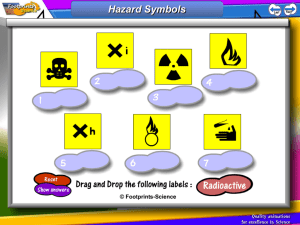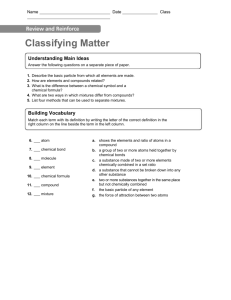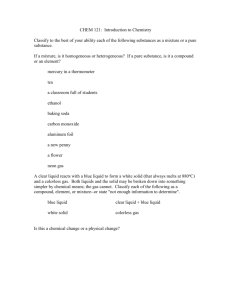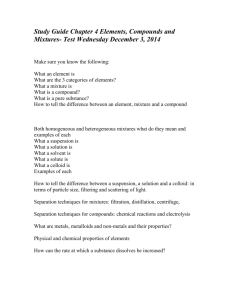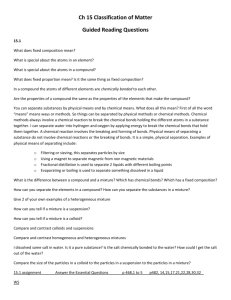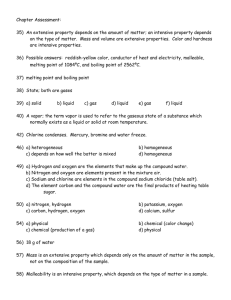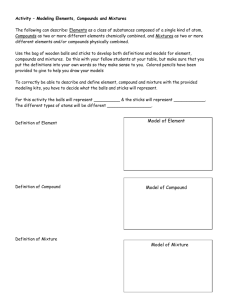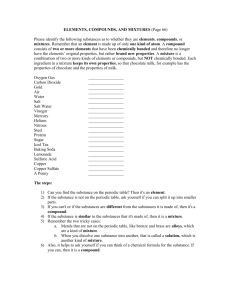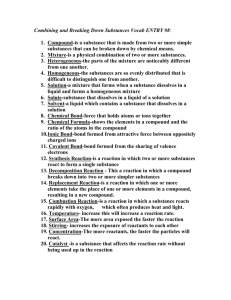Pre and post test Year 8 Chemistry Quiz 2013 1. Which list below
advertisement
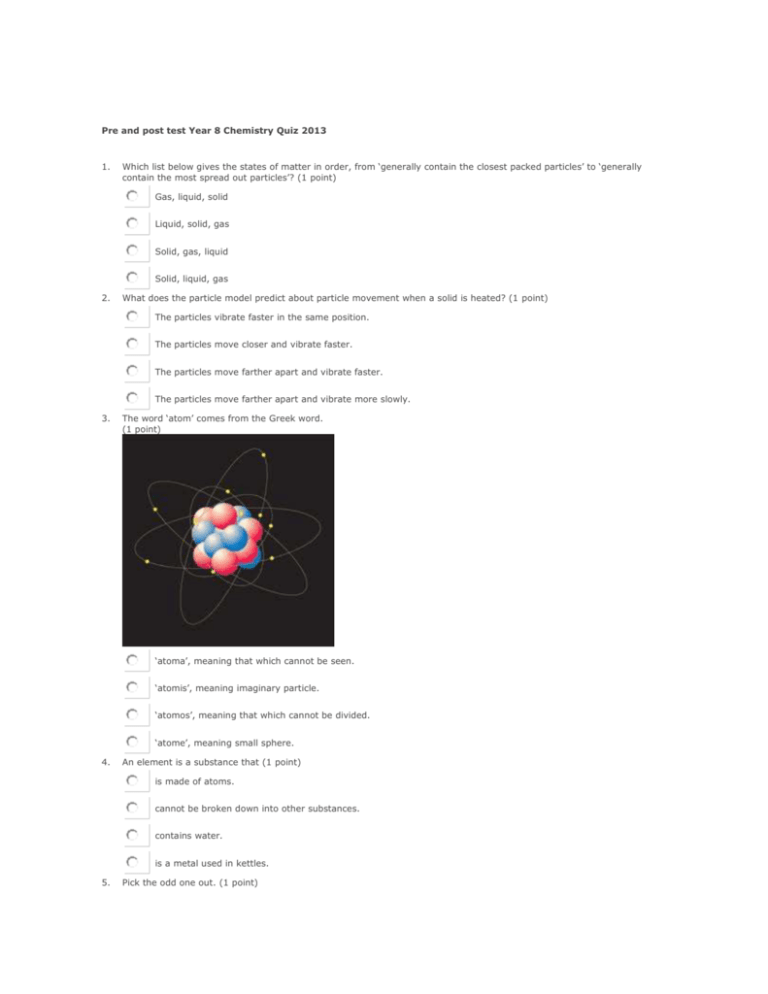
Pre and post test Year 8 Chemistry Quiz 2013 1. Which list below gives the states of matter in order, from ‘generally contain the closest packed particles’ to ‘generally contain the most spread out particles’? (1 point) Gas, liquid, solid Liquid, solid, gas Solid, gas, liquid Solid, liquid, gas 2. What does the particle model predict about particle movement when a solid is heated? (1 point) The particles vibrate faster in the same position. The particles move closer and vibrate faster. The particles move farther apart and vibrate faster. The particles move farther apart and vibrate more slowly. 3. The word ‘atom’ comes from the Greek word. (1 point) ‘atoma’, meaning that which cannot be seen. ‘atomis’, meaning imaginary particle. ‘atomos’, meaning that which cannot be divided. ‘atome’, meaning small sphere. 4. An element is a substance that (1 point) is made of atoms. cannot be broken down into other substances. contains water. is a metal used in kettles. 5. Pick the odd one out. (1 point) Sulfur Oxygen Copper Carbon 6. The lightest element is (1 point) lead hydrogen. lithium. carbon. 7. Identify the list that only contains non-metals. (1 point) oxygen; carbon; lithium helium; hydrogen; fluorine mercury; copper; zinc helium; hydrogen; silicon 8. The component of an atom that is positively charged is (1 point) a proton. an electron. a neutron. an element. 9. A compound (1 point) is made of different elements that are not strongly joined together. is made of different elements whose atoms are bonded strongly together. has similar characteristics to the elements it is made from. is a type of mixture containing only a few different types of atoms. 10. Which of the following is an example of a metalloid? (1 point) Germanium Iron Steel Carbon 11. Which of the following diagrams best represents a compound? (Different circles represent different atoms.) (1 point) A B C D 12. Which of the following is a chemical change? (1 point) An ice-cream melting Making a cup of tea Hard boiling an egg Boiling water to make steam 13. Classify Pure water as either element (E), compound (C) or mixture (M). (1 point) Element Compound Mixture 14. Classify Iron as either element (E), compound (C) or mixture (M). (1 point) Element Compound Mixture 15. Classify Air as either element (E), compound (C) or mixture (M). (1 point) Element Compound Mixture 16. Classify salt as either element (E), compound (C) or mixture (M). (1 point) Element Compound Mixture 17. Give a written definition of (a) an element. (b) a compound. (c) a mixture. (3 points) 18. Name two elements that are examples of (a) metals (b) non-metals (c) metalloids (6 points) 19. Give the symbols for the following elements. (10 points) _____ hydrogen _____ nitrogen _____ sodium _____ gold _____ iodine _____ fluorine _____ copper _____ boron a. Au b. N c. F d. H e. Na f. Cu g. Fe h. I i. B j. Li _____ lithium _____ iron 20. Describe (a) an example of a chemical change. (b) an example of a physical change. (2 points) 21. List 5 observations that provide evidence for a chemical change. (5 points) 22. Explain the difference between a chemical and a physical change. (4 points) 23. Complete the following response questions using the appropriate word. ????? are pure substances that contain only one type of atom (1 point) _______________ 24. Complete the following response questions using the appropriate word. In a ???????????? mixture the mixture is uniform throughout. _______________ (1 point) 25. Which of the following is NOT an example of a physical change.? (1 point) condensation filtration decomposition evaporation 26. Elements can be divided into two main groups (1 point) compounds and mixtures metals and non-metals pure and impure substances metals and compounds Version A Answer Sheet Year 8 Chemistry Quiz 2013 1. Solid, liquid, gas 2. The particles move farther apart and vibrate faster. 3. ‘atomos’, meaning that which cannot be divided. 4. cannot be broken down into other substances. 5. Copper 6. hydrogen. 7. helium; hydrogen; fluorine 8. a proton. 9. is made of different elements whose atoms are bonded strongly together. 10. Germanium 11. C 12. Hard boiling an egg 13. Compound 14. Element 15. Mixture 16. Compound 17. Answers may vary Sample Answer: (a) an element is a simple pure substance composed on one type of atom only. (b) a compound is a pure substance composed of two or more elements chemically combined in a fixed ratio. The compound made has unique new properties to the elements making them up. (c) A mixture is a combination of substances that can be elements and compounds not in a fixed ratio and they still possess the same properties of the substances making them up. (b) (c) 18. Answers may vary Sample Answer: Using your periodic table (a)eg of some metals are Ca, K, Mg, Al, Pg, Au (b) eg of some non-metals are H, S, Cl, N, Ar, and C (c)metalloids or semi-metals are B, Si, Ge, As 19. d, b, e, a, h, c, f, i, j, g 20. Answers may vary Sample Answer: (a)an example of chemical change is rusting, cooking food, photosynthesis and respiration (b) an example of a physical change is freezing water and boiling a liquid. 21. Answers may vary Sample Answer: 1.Heat given out or absorbed 2.Light produced 3. gas given off 4. a colour change 5. a new substance being made or disappearing or noise produced. 22. Answers may vary Sample Answer: A chemical change makes a new substance that has unique properties and is difficult to undo.A physical change does not form a new substance and involves a change in state and is easily undone. 23. elements 24. homeogeneous 25. decomposition 26. metals and non-metals
